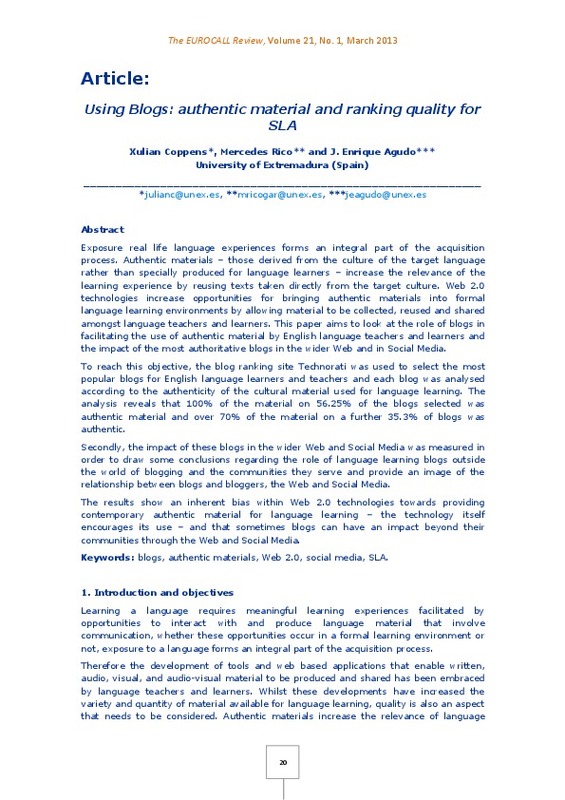JavaScript is disabled for your browser. Some features of this site may not work without it.
Buscar en RiuNet
Listar
Mi cuenta
Estadísticas
Ayuda RiuNet
Admin. UPV
Using Blogs: authentic material and ranking quality for SLA
Mostrar el registro sencillo del ítem
Ficheros en el ítem
| dc.contributor.author | Coppens, Xulian
|
es_ES |
| dc.contributor.author | Rico, Mercedes
|
es_ES |
| dc.contributor.author | Agudo, J. Enrique
|
es_ES |
| dc.date.accessioned | 2020-03-03T13:40:30Z | |
| dc.date.available | 2020-03-03T13:40:30Z | |
| dc.date.issued | 2013-03-16 | |
| dc.identifier.issn | 1695-2618 | |
| dc.identifier.uri | http://hdl.handle.net/10251/138299 | |
| dc.description.abstract | [EN] Exposure real life language experiences forms an integral part of the acquisition process. Authentic materials – those derived from the culture of the target language rather than specially produced for language learners – increase the relevance of the learning experience by reusing texts taken directly from the target culture. Web 2.0 technologies increase opportunities for bringing authentic materials into formal language learning environments by allowing material to be collected, reused and shared amongst language teachers and learners. This paper aims to look at the role of blogs in facilitating the use of authentic material by English language teachers and learners and the impact of the most authoritative blogs in the wider Web and in Social Media. To reach this objective, the blog ranking site Technorati was used to select the most popular blogs for English language learners and teachers and each blog was analysed according to the authenticity of the cultural material used for language learning. The analysis reveals that 100% of the material on 56.25% of the blogs selected was authentic material and over 70% of the material on a further 35.3% of blogs was authentic. Secondly, the impact of these blogs in the wider Web and Social Media was measured in order to draw some conclusions regarding the role of language learning blogs outside the world of blogging and the communities they serve and provide an image of the relationship between blogs and bloggers, the Web and Social Media. The results show an inherent bias within Web 2.0 technologies towards providing contemporary authentic material for language learning – the technology itself encourages its use – and that sometimes blogs can have an impact beyond their communities through the Web and Social Media. | es_ES |
| dc.language | Inglés | es_ES |
| dc.publisher | Universitat Politècnica de València | es_ES |
| dc.relation.ispartof | The EuroCALL Review | es_ES |
| dc.rights | Reconocimiento - No comercial - Sin obra derivada (by-nc-nd) | es_ES |
| dc.subject | Blogs | es_ES |
| dc.subject | Authentic materials | es_ES |
| dc.subject | Web 2.0 | es_ES |
| dc.subject | Social media | es_ES |
| dc.subject | SLA | es_ES |
| dc.title | Using Blogs: authentic material and ranking quality for SLA | es_ES |
| dc.type | Artículo | es_ES |
| dc.identifier.doi | 10.4995/eurocall.2013.10160 | |
| dc.rights.accessRights | Abierto | es_ES |
| dc.description.bibliographicCitation | Coppens, X.; Rico, M.; Agudo, JE. (2013). Using Blogs: authentic material and ranking quality for SLA. The EuroCALL Review. 21(1):20-34. https://doi.org/10.4995/eurocall.2013.10160 | es_ES |
| dc.description.accrualMethod | OJS | es_ES |
| dc.relation.publisherversion | https://doi.org/10.4995/eurocall.2013.10160 | es_ES |
| dc.description.upvformatpinicio | 20 | es_ES |
| dc.description.upvformatpfin | 34 | es_ES |
| dc.type.version | info:eu-repo/semantics/publishedVersion | es_ES |
| dc.description.volume | 21 | es_ES |
| dc.description.issue | 1 | es_ES |
| dc.relation.pasarela | OJS\10160 | es_ES |
| dc.description.references | Benkler, Y. (2006). The Wealth of Networks: how social production transforms markets and freedom. Yale University Press. | es_ES |
| dc.description.references | Castells, M. (2001). The Internet Galaxy. Oxford University Press . | es_ES |
| dc.description.references | Castells, M. (2002). Cultura XXI. La dimensión cultural de Internet. Universitat Oberta de Catalunya. | es_ES |
| dc.description.references | De Haro, J.J. (2008). "Las redes sociales en educación", Educativa: Blog sobre calidad e innovación en Educación Secundaria. Retrieved 8 November 2008 from http://jjdeharo.blogspot.com/2008/11/la-redes-sociales-en-educacin.html. | es_ES |
| dc.description.references | Downes, S. (2005). "E-learning 2.0.", ACM eLearn Magazine National Research Council of Canada. Retrieved 16 October 2005 from http://www.downes.ca/post/31741. | es_ES |
| dc.description.references | Alex Gilmore (2007). "Authentic materials and authenticity in foreign language learning", Language Teaching, 40, pp. 97-118. doi:10.1017/S0261444807004144. | es_ES |
| dc.description.references | Harmer, J. (1991). The Practice of English Language Teaching. Pearson Longman. | es_ES |
| dc.description.references | Krashen, S. & Terrell, T.D. (1983). The Natural Approach. Pergamon Press. | es_ES |
| dc.description.references | Krashen, S. (1985). The Input Hypothesis: Issues and Implications. Longman. | es_ES |
| dc.description.references | Nation, P. (2007). The Four Strands in Innovation in Language Learning and Teaching, Volume 1, Issue 1, April 2007, pages 2-13. | es_ES |
| dc.description.references | Reig, D. (marzo, 2008) ¿Por qué internet en el aula? Presentación de Teemu Arina. El Caparazón. [Blog] http://www.dreig.eu/caparazon/2008/03/17/%C2%BFporqueinternet-en-el-aula-cooperacionconocimientodiversidadtoleranciaa-partir-de-unapresentacion-de-t-arina/ | es_ES |
| dc.description.references | Rico, M. et al (2009). "How well are teachers and students prepared for Web 2.0 best practices?", Research, Reflections and Innovations in Integrating ICT in Education. A. Méndez-Vilas, A. Solano Martín, J.A. Mesa González and J. Mesa González (Eds.). Badajoz: Formatex. | es_ES |
| dc.description.references | Swain, M. and Lapkin, S. (1995). "Problems in output and the cognitive processes they generate: step towards second language learning", Applied Linguistics, 16:371-391. | es_ES |
| dc.description.references | Technorati Authority FAQ - Technorati. (2012). Retrieved October 4, 2012, from http://technorati.com/what-is-technorati-authority. | es_ES |








